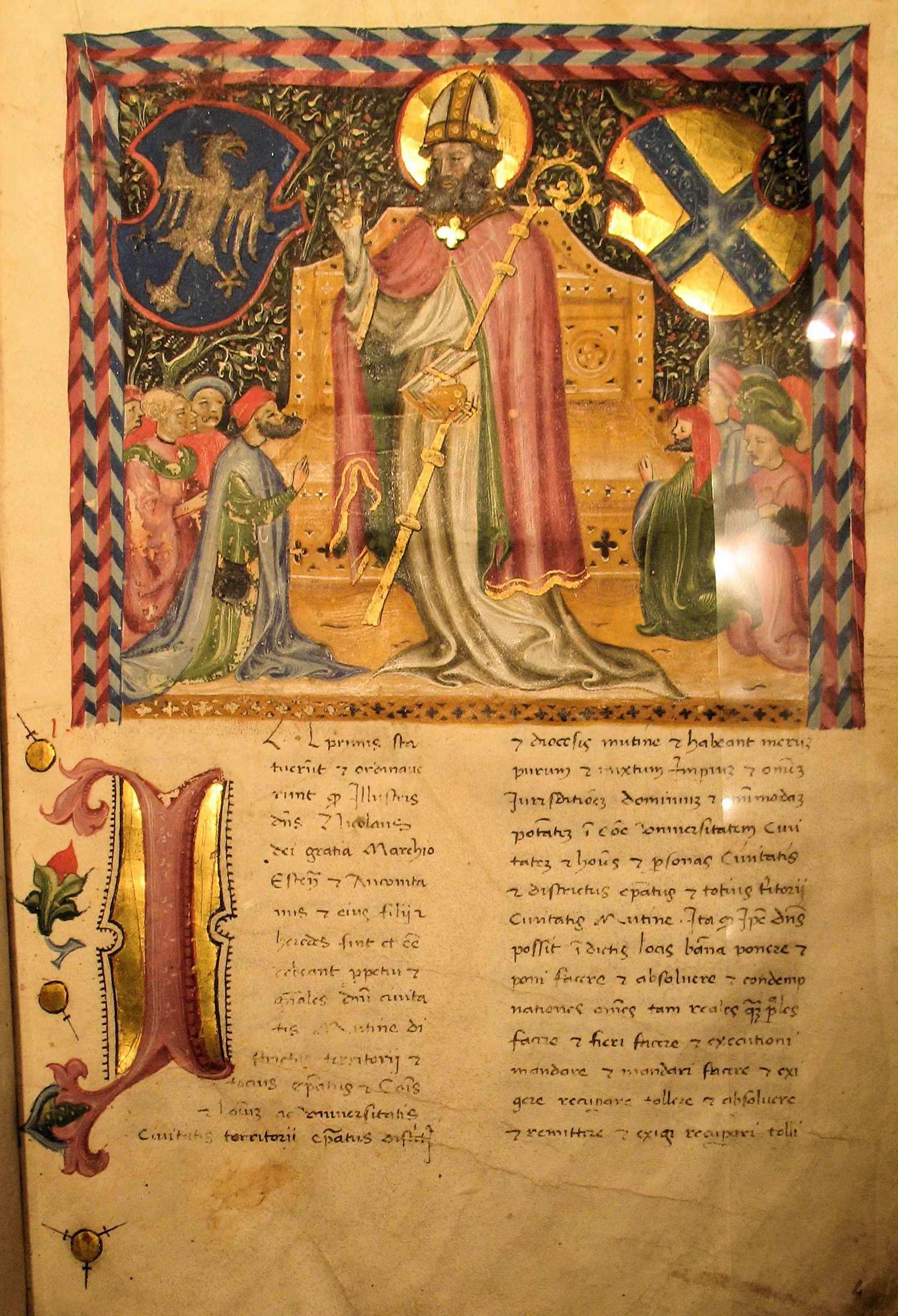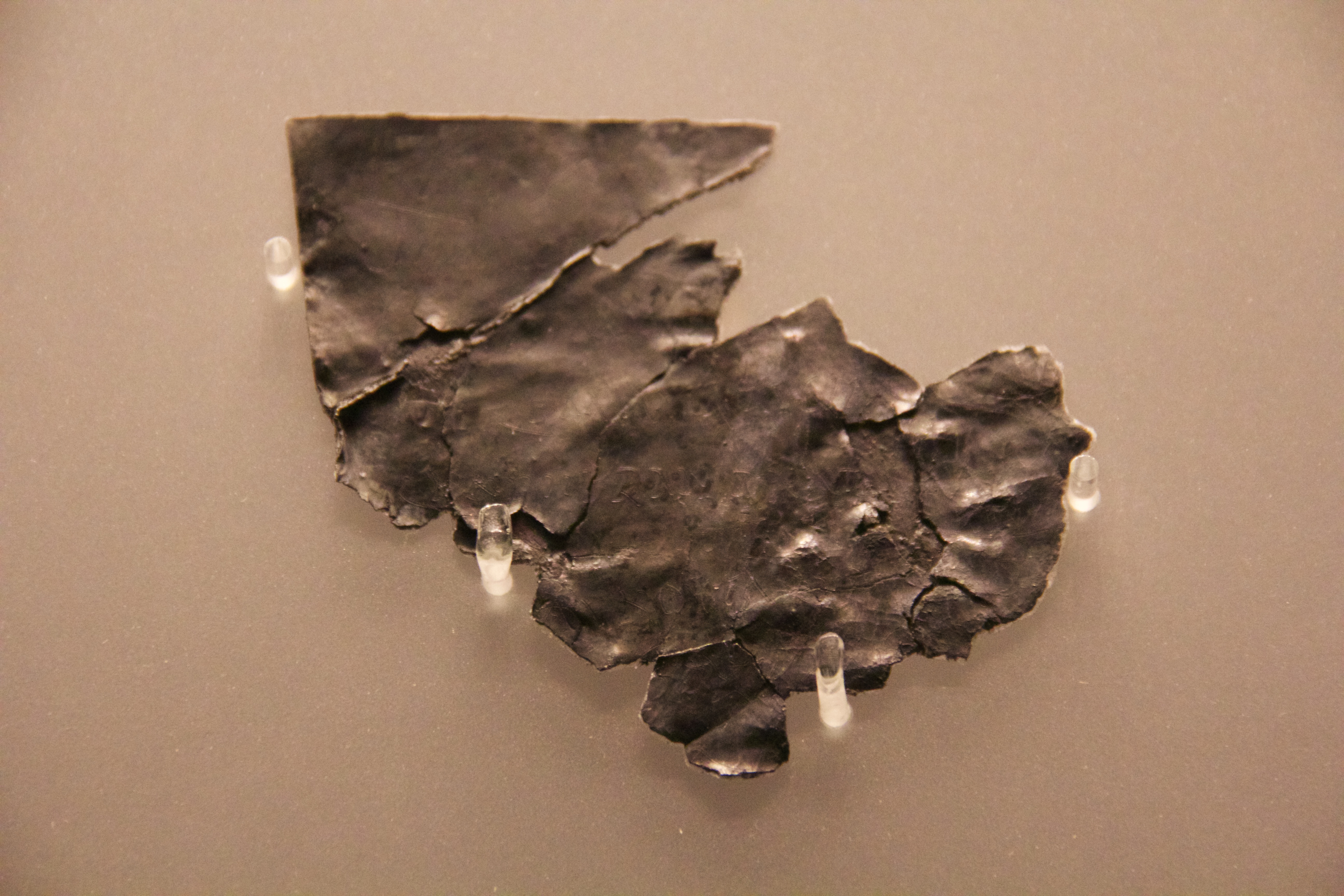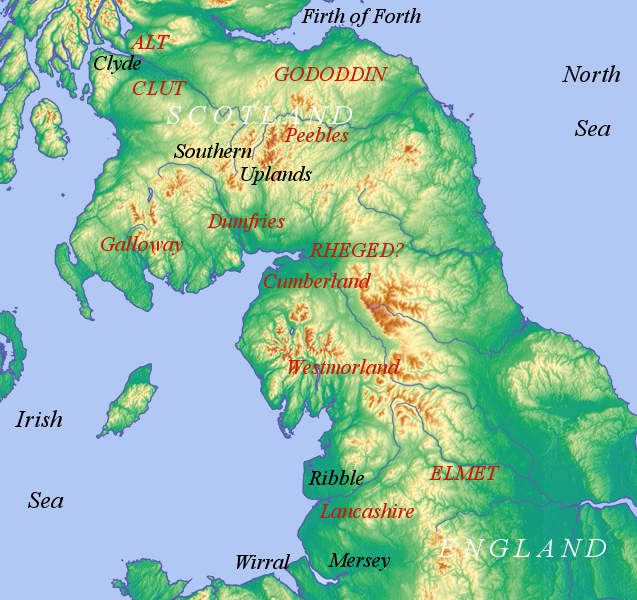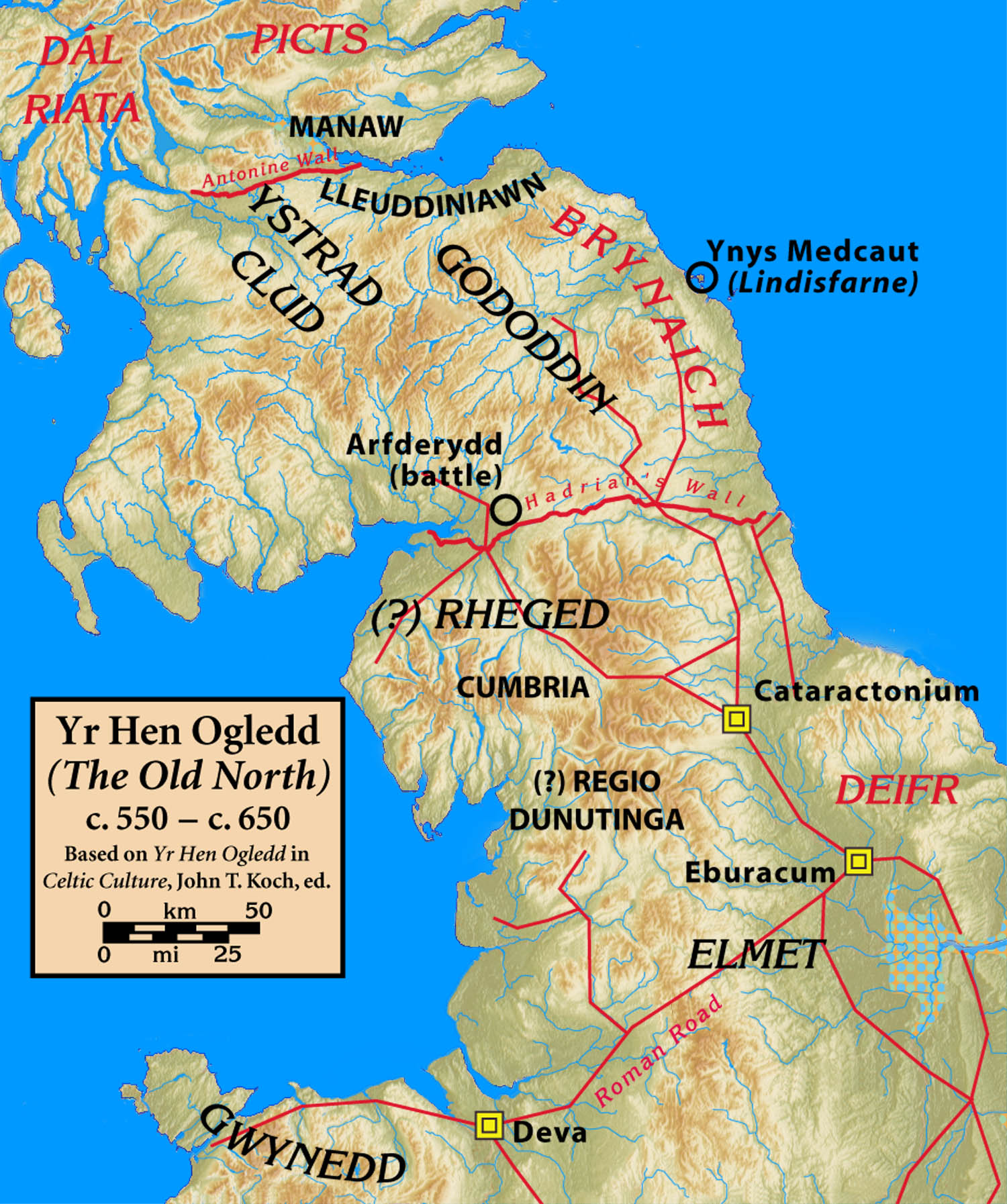|
Medieval Welsh Literature
Medieval Welsh literature is the literature written in the Welsh language during the Middle Ages. This includes material starting from the 5th century AD, when Welsh was in the process of becoming distinct from Common Brittonic, and continuing to the works of the 16th century. The Welsh language became distinct from other dialects of Old British sometime between AD 400 and 700; the earliest surviving literature in Welsh is poetry dating from this period. The poetic tradition represented in the work of ''Y Cynfeirdd'' ("The Early Poets"), as they are known, then survives for over a thousand years to the work of the ''Poets of the Nobility'' in the 16th century. The core tradition was praise poetry; and the poet Taliesin was regarded as the first in the line. The other aspect of the tradition was the professionalism of the poets and their reliance on patronage from kings, princes and nobles for their living, similar to the way Irish bards and Norse skalds were patronized for th ... [...More Info...] [...Related Items...] OR: [Wikipedia] [Google] [Baidu] |
Medieval Literature
Medieval literature is a broad subject, encompassing essentially all written works available in Europe and beyond during the Middle Ages (that is, the one thousand years from the fall of the Western Roman Empire ca. AD 500 to the beginning of the Renaissance in the 14th, 15th or 16th century, depending on country). The literature of this time was composed of religious writings as well as secular works. Like modern literature, it is a broad field of study, from the utterly sacred to the exuberantly profane, touching all points in between. Works of literature are often grouped by place of origin, language, and genre. Languages Outside of Europe, medieval literature was written in Geʽez, Ethiopic, Syriac language, Syriac, Coptic language, Coptic, Japanese language, Japanese, Chinese language, Chinese, and Arabic, among many other languages. In Western Europe, Latin was the common language for medieval writing, since Latin was the language of the Roman Catholic Church, which domin ... [...More Info...] [...Related Items...] OR: [Wikipedia] [Google] [Baidu] |
Normans
The Normans (Norman language, Norman: ''Normaunds''; ; ) were a population arising in the medieval Duchy of Normandy from the intermingling between Norsemen, Norse Viking settlers and locals of West Francia. The Norse settlements in West Francia followed a series of raids on the French northern coast mainly from what is now Denmark, although some also sailed from Norway and Sweden. These settlements were finally legitimized when Rollo, a Scandinavian Vikings, Viking leader, agreed to swear fealty to Charles the Simple, King Charles III of West Francia following the Siege of Chartres (911), siege of Chartres in 911, leading to the formation of the ''County of Rouen''. This new fief, through kinship in the decades to come, would expand into what came to be known as the ''Duchy of Normandy''. The Norse settlers, whom the region as well as its inhabitants were named after, adopted the language, Christianity, religion, culture, social customs and military, martial doctrine of the Wes ... [...More Info...] [...Related Items...] OR: [Wikipedia] [Google] [Baidu] |
Brythonic Languages
The Brittonic languages (also Brythonic or British Celtic; ; ; and ) form one of the two branches of the Insular Celtic languages; the other is Goidelic. It comprises the extant languages Breton, Cornish, and Welsh. The name ''Brythonic'' was derived by Welsh Celticist John Rhys from the Welsh word , meaning Ancient Britons as opposed to an Anglo-Saxon or Gael. The Brittonic languages derive from the Common Brittonic language, spoken throughout Great Britain during the Iron Age and Roman period. In the 5th and 6th centuries emigrating Britons also took Brittonic speech to the continent, most significantly in Brittany and Britonia. During the next few centuries, in much of Britain the language was replaced by Old English and Scottish Gaelic, with the remaining Common Brittonic language splitting into regional dialects, eventually evolving into Welsh, Cornish, Breton, Cumbric, and probably Pictish. Welsh and Breton continue to be spoken as native languages, while ... [...More Info...] [...Related Items...] OR: [Wikipedia] [Google] [Baidu] |
Aneirin
Aneirin (), also rendered as Aneurin or Neirin and Aneurin Gwawdrydd, was an early Medieval Brythonic war poet who lived during the 6th century. He is believed to have been a bard or court poet in one of the Cumbric kingdoms of the Hen Ogledd, probably that of Gododdin at Edinburgh, in modern Scotland. From the 17th century, he was usually known as Aneurin. Life Some records indicate that Aneirin was the son of Caunus (or Caw) and brother to Gildas. According to this version of his life, he was born at Dumbarton on the River Clyde. However, some scholars debate this parentage, and contend that these records are of later invention and are erroneous. Whoever his father was, Aneirin's mother, Dwywei is mentioned in '' Y Gododdin''. She may be the same lady who, according to Old Welsh pedigrees, married King Dunod who is generally thought to have ruled in the West Riding of Yorkshire. He may also be kin to another Brythonic poet, Cian Gwenith Gwawd. Aneirin's patrons were the no ... [...More Info...] [...Related Items...] OR: [Wikipedia] [Google] [Baidu] |
Talhaearn Tad Awen
Talhaearn Tad Awen (''fl'' mid-6th century), was, according to medieval Welsh sources, a celebrated British poet of the sub-Roman period. He ranks as one of the earliest, if not the earliest, named poets to have composed and performed in Welsh. The better known poets Aneirin and Taliesin, who may have been slightly younger contemporaries, also belong to this early generation, the first of those known to modern scholars as the '' Cynfeirdd'' ("first poets"). Whereas medieval Welsh manuscripts preserve verse composed by or otherwise ascribed to the latter two figures, no such work survives for Talhaearn and in fact, his former fame seems to have largely vanished by the later Middle Ages. ''Historia Brittonum'' An interpolated passage in the ''Historia Brittonum'' (9th century) describes him as a famous poet, along with Aneirin, Taliesin and two lesser known figures, Blwchfardd and Cian: :''Tunc Talhaern Tat Aguen in poemate claruit, et Neirin, et Taliessin, et Bluchbard, et Cian q ... [...More Info...] [...Related Items...] OR: [Wikipedia] [Google] [Baidu] |
Ida Of Bernicia
Ida (; died ) is the first known king of the Anglian kingdom of Bernicia, which he ruled from around 547 until his death in 559. Little is known of his life or reign, but he was regarded as the founder of a line from which later Angle kings in this part of central Great Britain claimed descent. His descendants overcame Brittonic resistance and ultimately founded the powerful kingdom of Northumbria. Sources The ''Anglo-Saxon Chronicle'' indicates that Ida's reign began in 547, and records him as the son of Eoppa, grandson of Esa, and great-grandson of Ingwy. Likewise, the ''Historia Brittonum'' calls him as the son of Eoppa and the first king of ''Berneich'' or Bernicia. The ''Anglo-Saxon Chronicle'' elaborates that he ruled for twelve years and built the Bernician capital of Bamburgh Castle. Later, however, the ''Chronicle'' confuses his territory with the later Northumbria, saying that Ælla, historically a king of Deira rather than Bernicia, succeeded him as king after his ... [...More Info...] [...Related Items...] OR: [Wikipedia] [Google] [Baidu] |
Nennius
Nennius – or Nemnius or Nemnivus – was a Welsh monk of the 9th century. He has traditionally been attributed with the authorship of the ''Historia Brittonum'', based on the prologue affixed to that work. This attribution is widely considered a secondary (10th-century) tradition. Nennius was a student of Elvodugus, commonly identified with the bishop Elfodd of Bangor who convinced British ecclesiastics to accept the Continental dating for Easter, and who died in 809 according to the '' Annales Cambriae''. Nennius is believed to have lived in the area made up by Brecknockshire and Radnorshire in present-day Powys, Wales. Thus, he lived outside the Anglo-Saxon kingdoms, isolated by mountains in a rural society. Because of the lack of evidence concerning the life of Nennius, he has become the subject of legend himself. Welsh traditions include Nennius with Elbodug and others said to have escaped the massacre of Welsh monks by Ethelfrid in 613, fleeing to the north. Authorsh ... [...More Info...] [...Related Items...] OR: [Wikipedia] [Google] [Baidu] |
Historia Brittonum
''The History of the Britons'' () is a purported history of early Britain written around 828 that survives in numerous recensions from after the 11th century. The ''Historia Brittonum'' is commonly attributed to Nennius, as some recensions have a preface written in that name. Some experts have dismissed the Nennian preface as a late forgery and argued that the work was actually an anonymous compilation. Overview The ''Historia Brittonum'' describes the supposed settlement of Britain by Trojan settlers and says that Britain was named for Brutus, a descendant of Aeneas. The "single most important source used by Geoffrey of Monmouth in his pseudohistorical ''Historia Regum Britanniae''" and through the enormous popularity of the latter work, this version of the early history of Britain, including the Trojan origin tradition, was incorporated into subsequent chronicles of the long-running history of the land, such as the Middle English '' Brut of England'', also known as ' ... [...More Info...] [...Related Items...] OR: [Wikipedia] [Google] [Baidu] |
Old Welsh
Old Welsh () is the stage of the Welsh language from about 800 AD until the early 12th century when it developed into Middle Welsh.Koch, p. 1757. The preceding period, from the time Welsh became distinct from Common Brittonic around 550, has been called "Primitive"Koch, p. 1757. or "Archaic Welsh". Phonology The phonology of Old Welsh is as follows. * Older was diphthongized into in (stressed) final syllables, but it was retained elsewhere. Whilst this persisted as a diphthong in Middle Welsh, in Modern Welsh /aw/ has collapsed to following the stress shift to the penultimate, except in monosyllables. * and were allophones of and in unstressed non-final syllables. In Middle Welsh these merged to . * Old Welsh and became and in Modern Welsh final syllables, in dialects where /ɨ/ has not merged with /i/. Texts The oldest surviving text entirely in Old Welsh is understood to be that on a gravestone now in Tywyn – the Cadfan Stone – thought to date from the ... [...More Info...] [...Related Items...] OR: [Wikipedia] [Google] [Baidu] |
British Language (Celtic)
Common Brittonic (; ; ), also known as British, Common Brythonic, or Proto-Brittonic, is a Celtic languages, Celtic language historically spoken in Great Britain, Britain and Brittany from which evolved the later and modern Brittonic languages. It is a form of Insular Celtic languages, Insular Celtic, descended from Proto-Celtic language, Proto-Celtic, a theorized parent language that, by the first half of the first millennium BC, was Divergence (linguistics), diverging into separate dialects or languages. Pictish language, Pictish is linked, most probably as a sister language or a descendant branch. Evidence from early and modern Welsh shows that Common Brittonic was significantly influenced by Latin during the Roman Britain, Roman period, especially in terms related to the Latin Church, church and Western Christianity, Christianity. By the sixth century AD, the languages of the Celtic Britons were rapidly diverging into Neo-Brittonic: Welsh language, Welsh, Cumbric, Cornish l ... [...More Info...] [...Related Items...] OR: [Wikipedia] [Google] [Baidu] |
Cumbric
Cumbric is an extinct Celtic language of the Brittonic subgroup spoken during the Early Middle Ages in the ''Hen Ogledd'' or "Old North", in Northern England and the southern Scottish Lowlands. It was closely related to Old Welsh and the other Brittonic languages. Place-name evidence suggests Cumbric may also have been spoken as far south as Pendle and the Yorkshire Dales. The prevailing view is that it became extinct in the 12th century, after the incorporation of the Kingdom of Strathclyde into the Kingdom of Scotland. Problems with terminology Dauvit Broun sets out the problems with the various terms used to describe the Cumbric language and its speakers.Broun, Dauvit (2004): 'The Welsh identity of the kingdom of Strathclyde, ca 900-ca 1200', ''Innes Review'' 55, pp 111–80. The people seem to have called themselves the same way that the Welsh called themselves (most likely from reconstructed Brittonic meaning "fellow countrymen"). The Welsh and the Cumbric-speaki ... [...More Info...] [...Related Items...] OR: [Wikipedia] [Google] [Baidu] |
Hen Ogledd
Hen Ogledd (), meaning the Old North, is the historical region that was inhabited by the Celtic Britons, Brittonic people of sub-Roman Britain in the Early Middle Ages, now Northern England and the southern Scottish Lowlands, alongside the fellow Brittonic Celtic Elmet, Kingdom of Elmet, in Yorkshire. Its population spoke a variety of the Brittonic languages, Brittonic language known as Cumbric which is closely related to, if not a dialect of Old Welsh. The Welsh people, people of Wales and the Hen Ogledd considered themselves to be one people, and both were referred to as Cymry ('fellow-countrymen') from the Brittonic word ''combrogi''. The Hen Ogledd was distinct from the parts of Great Britain inhabited by the Picts, Anglo-Saxons, and Scoti. The major kingdoms of the Hen Ogledd were Elmet, Gododdin, Rheged, and the Kingdom of Strathclyde (Welsh: ''Ystrad Clud''). Smaller kingdoms included Aeron (kingdom), Aeron and Calchfynydd. Eidyn, Lothian, Lleuddiniawn, and Manaw Gododdin ... [...More Info...] [...Related Items...] OR: [Wikipedia] [Google] [Baidu] |




